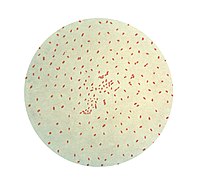
Photo from wikipedia
OBJECTIVE To estimate the incidence, duration and risk factors for diagnostic delays associated with pertussis. DESIGN We used longitudinal retrospective insurance claims from the Marketscan Commercial Claims and Encounters, Medicare… Click to show full abstract
OBJECTIVE To estimate the incidence, duration and risk factors for diagnostic delays associated with pertussis. DESIGN We used longitudinal retrospective insurance claims from the Marketscan Commercial Claims and Encounters, Medicare Supplemental (2001-2020), and Multi-State Medicaid (2014-2018) databases. SETTING Inpatient, emergency department, and outpatient visits. PATIENTS The study included patients diagnosed with pertussis (International Classification of Diseases [ICD] codes) and receipt of macrolide antibiotic treatment. METHODS We estimated the number of visits with pertussis-related symptoms before diagnosis beyond that expected in the absence of diagnostic delays. Using a bootstrapping approach, we estimated the number of visits representing a delay, the number of missed diagnostic opportunities per patient, and the duration of delays. Results were stratified by age groups. We also used a logistic regression model to evaluate potential factors associated with delay. RESULTS We identified 20,828 patients meeting inclusion criteria. On average, patients had almost 2 missed opportunities prior to diagnosis, and delay duration was 12 days. Across age groups, the percentage of patients experiencing a delay ranged from 29.7% to 37.6%. The duration of delays increased considerably with age from an average of 5.6 days for patients aged <2 years to 13.8 days for patients aged ≥18 years. Factors associated with increased risk of delays included emergency department visits, telehealth visits, and recent prescriptions for antibiotics not effective against pertussis. CONCLUSIONS Diagnostic delays for pertussis are frequent. More work is needed to decrease diagnostic delays, especially among adults. Earlier case identification may play an important role in the response to outbreaks by facilitating treatment, isolation, and improved contact tracing.
Journal Title: Infection control and hospital epidemiology
Year Published: 2023
Link to full text (if available)
Share on Social Media: Sign Up to like & get
recommendations!